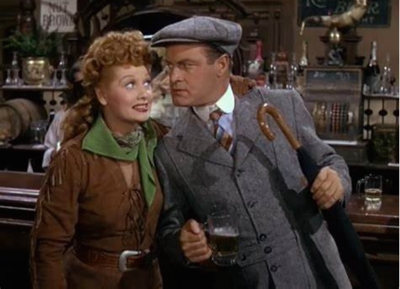Grade: B-/C+
Comedy-Drama
Not rated (would be PG)
Child actor Shirley Temple became a household name in the 1930s and was considered to be 20th Century-Fox’s greatest asset. When she was only seven years old, the studio assigned a team of 19 writers to develop original stories for her. Discovered at age three, she became the inspiration for stage mothers all across America who pushed their own small children to become singers and dancers. Her signature song (“On the Good Ship Lollipop”) sold 500,000 copies on sheet music—presumably to those same stage mothers—while her likeness was used to sell such merchandise as dolls, clothing, plates, and glassware. She even had a drink named for her, and was the first performer to receive a special Juvenile Oscar.
By the time a six-year-old (but looking younger) Temple appeared in Little Miss Marker (1934)—the film that established her as a star—she had already acted in 13 film shorts and nine feature films. By contrast, Dorothy Bell, the female lead who plays a nightclub singer in this Damon Runyon adaptation, had only one film short and a single feature to her credit.
Runyon was a journalist whose published short stories celebrated the denizens of Prohibition-era Broadway: hard-boiled newsmen, gamblers, bookies, singers, racketeers, reformers, and other colorful characters that inhabited his little corner of Brooklyn. They were people who frequented racetracks and clubs, had colorful nicknames, yet had a soft spot. If you’ve seen Guys and Dolls, you’ve seen the most famous adaptation of two of his short stories. But “Little Miss Marker” comes in second, having spawned this film and three remakes.
In Little Miss Marker, bookie Sorrowful Jones (Adolphe Menjou) accepts an unusual I.O.U. “marker”: the daughter of a desperate man looking to get back on track with a racing win. When the man never returns to get her and pay his debt, the bookie is forced to take the child home. Soon he, his associates, and everyone under the thumb of racketeer Big Steve (Charles Bickford) find themselves being charmed by her. That includes the racketeer’s girlfriend, club singer Bangles (Dell), who envisions a more respectable life when she looks at the orphan.
Of Temple films, then-President Franklin D. Roosevelt said, “It is a splendid thing that for just 15 cents, an American can go to a movie and look at the smiling face of a baby and forget his troubles.” But not everyone could forget their troubles. America wasn’t exactly equal, and films from this era, with their unfortunate racial stereotypes, are a reminder of that. Willie Best, like Stepin Fetchit, played a lazy, simpleminded, easily spooked character whose eyes bug out and words meander in a slow exaggerated drawl. But at least he received credit for his work, as did Wong Chung for a single walk-on line spoken again as an stereotypical caricature of what white America thought Asians sounded like when they spoke English. Mildred Gover, who plays the club singer’s maid, isn’t even credited . . . though at least her delivery seems less caricatured as the film progresses. At one point we even catch her having a drink and putting her feet up on the furniture when the missus isn’t home.
So yeah, a few unfortunate cultural stereotypes mar a film that otherwise is entertaining in a hokey sort of way. Hardened men and women become like putty in the hands of “Marky.” When they realize they’re having as much of a negative effect on her as the positive effect she’s having on them, they resolve to do something about it—even if it involves sabotaging Big Steve’s plan to use the girl as “owner” of a racehorse that they plan to use to fix a race, or holding an elaborate dress-up party to refuel the child’s belief in fairy tales. And even if it means kidnapping a doctor when, like Pollyanna, Marky needs emergency care.
Shirley Temple was America’s screen orphan and her movies were a mainstay on family-oriented TV movie series of the ‘50s and ‘60s. But these days the safest ones to watch with your small children remain those that are the least outdated and have the fewest unsavory characters in need of transformation.
Those would be Heidi (1937), The Little Princess (1939), Bright Eyes (1934, “The Good Ship Lollipop” film), and Captain January (1936), in that order. But Wee Willie Winkie (1937, Temple’s favorite) and Little Miss Marker aren’t far behind. While this Little Miss Marker might lose by a nose to Bob Hope’s Sorrowful Jones (1949), it remains far superior to the 1980 adaptation or looser remakes like Little Big Shot (1935) or Forty Pounds of Trouble (1962).
Entire family: Yes
Run time: 80 min. Black & White
Studio/Distributor: Universal/Kino Lorber
Aspect ratio: 1.37:1
Featured audio: DTS 2.0 Mono
Bonus features: C+
Rated “Passed” (would be G today)






















